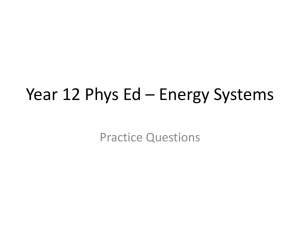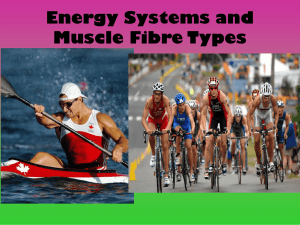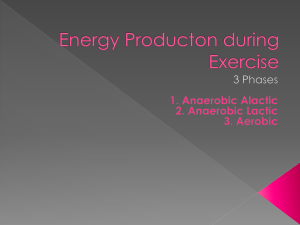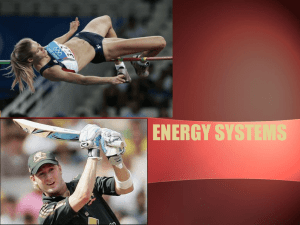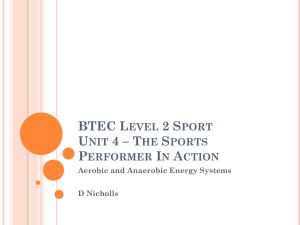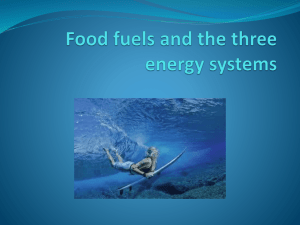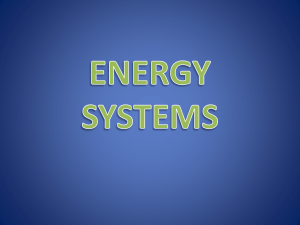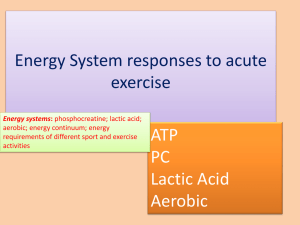Aerobic and Anaerobic Pathways- An Introduction to Energy Systems
advertisement
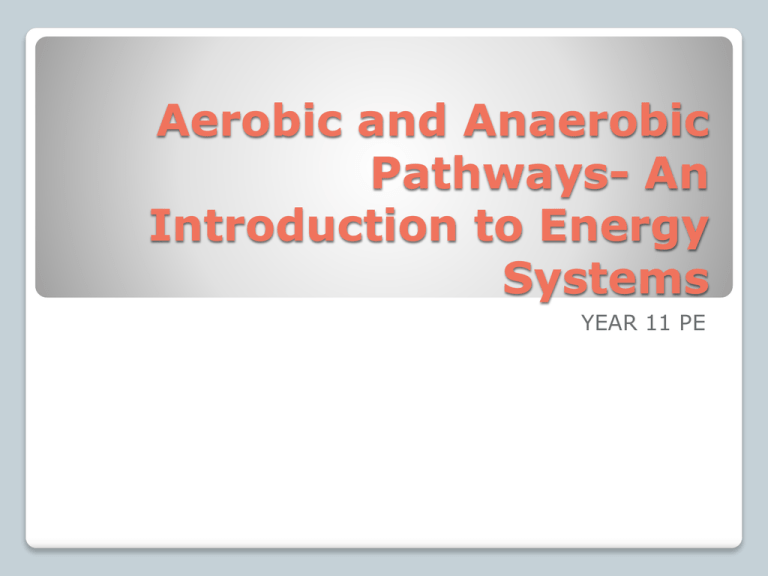
Aerobic and Anaerobic Pathways- An Introduction to Energy Systems YEAR 11 PE Chapter Overview ATP (adenosine triphosphate) is used for muscle contraction. This is stored in muscles (in small amounts) and can be converted from food fuel sources. During exercise, ATP is broken down to adenosine diphosphate (ADP) and phosphate molecule. As ATP stores as depleted, resynthesis occurs to convert ADP back to ATP. 3 energy systems: ATP-PC system (No O² required) Anaerobic glycolysis- Lactic acid system (No O² required) Aerobic system (O² required) ATP for energy use Food is our primary energy source. These sources include carbohydrates, fats and protein. Our main fuel source is carbohydrates, with protein used very sparingly. Foods and their Conversion to Energy Immediately available, quickest source of energy (PC) Does not require O² Dominant energy system for first 1-5 secs of exercise, peak power between 2-4 secs Depleted after 10 secs of exercise Once PC has been depleted, 50 per cent replenishment is achieved within 30 seconds of passive recovery, total replenishment takes 3+ minutes. ATP-PC SYSTEM Used for high-intensity activities involving explosive movements such as sprinting, long jumping and throwing the javelin. Linked to the fitness components of muscular power and speed. PC is not used for muscle contraction, it is mainly used for resynthesising ATP. ATP is broken down to adenosine diphosphate (ADP). As rapidly as this breakdown occurs, the remaining PC is broken down to join with the ADP to form ATP again. This is the resynthesising process of ATP. ATP-PC SYSTEM ATP-PC SYSTEM 1. What is the body’s primary source of energy? 1. Why do we call upon the ATP-PC system at the start at exercise? Check Your Understanding Glycogen is broken down to form ATP. Lactic acid is produced as a by-product to energy release Does not require O² Predominant energy system for activity lasting 10-75 secs, peak power occurs between 5-15 secs. Used for activity including 100-metre freestyle swimming at the elite level, or gymnastics routines. Linked to the fitness components of muscular power and speed. ANAEROBIC GLYCOLYSIS ANAEROBIC GLYCOLYSIS Requires O² Glycogen is broken down to form ATP without producing any by-products. At rest or during extended endurance activity, aerobic system uses fats. Fats can produce more ATP than carbohydrates, but they require more oxygen to produce the equivalent amount of ATP. Peak power occurs between 1 and 2 minutes. Dominant system for activities that are more than 75 seconds in total duration. AEROBIC SYSTEM 3 stages in aerobic energy production Stage 1 – the breakdown of carbohydrates and fats to produce 2 ATP molecules Stage 2 – Kreb’s cycle, which involves the breakdown of pyruvic acid into carbon dioxide. Further energy is released to resynthesise to ATP for a net production of 1 ATP molecule. Stage 3 – the electron transport stage, which involves water, heat and produces the largest yield of ATP – a total of 34 molecules AEROBIC SYSTEM ANAEROBIC VS AEROBIC The 3 energy systems Fuel Oxygen? Max ATP produced (moles) Peak power in Max effort Typical events 100m jumps throws hitting ByRecovery Intensity products time Small amount of stored ATP Phosphocreatine (PC) - broken down to make more ATP NO 0.7 2-4 sec Lactic Acid Glycogen - from System Carbohydrates NO 1.2 5-15 sec 200400m lactic acid 50m swim YES 98 (38per mole of glycogen) 1-2 min marathon cycling archery ATP-PC System Aerobic System Carbohydrates Fats 3 ENERGY SYSTEMS nil H20 CO2 Heat 95-100% 50% in 30sec 100% in 3 min 85-100% 20min - 2 hr 60-85% up to 25days 1. What is the by-product produced by anaerobic glycolysis? 2. How do the aerobic and anaerobic systems differ? Check Your Understanding All three energy systems are activated at the start of exercise and no single system works by itself. ENERGY SYSTEM INTERPLAY All 3 systems begin to produce energy at the start of the event. The ATP-PC system contributes by far the most ATP (energy) in the first 5 seconds, after this time the PC is depleted to about 50% The Lactic Acid system is at its peak between 5-15 seconds so it becomes the major contributor as the ATP-PC system slows down from 5 seconds. The ATP-PC system continues to supply ATP until fully depleted after around 10-15 seconds. The Lactic Acid system continues to be the major contributor until around 30 seconds when the Aerobic system has had time to begin to supply more ATP. The Lactic Acid system begins to slow down after 30 seconds as the Aerobic system takes over more. The Lactic Acid system continues to supply some ATP for the duration – but has slowed down to avoid fatigue caused by excessive Lactic Acid accumulation. The Lactic Acid system supplies the most ATP for this event. 400m Race example Choose either shotput, 100m or 800m event In regards to this event, explain the contribution of each energy system. Explain the interplay relationship between the energy systems eg. 400m race Check Your Understanding


